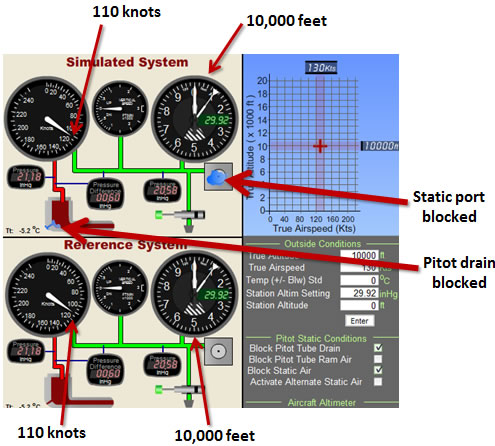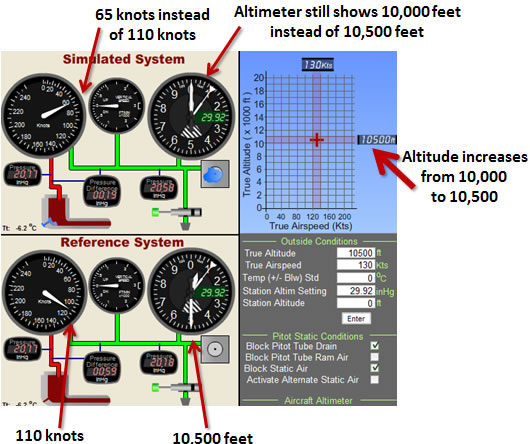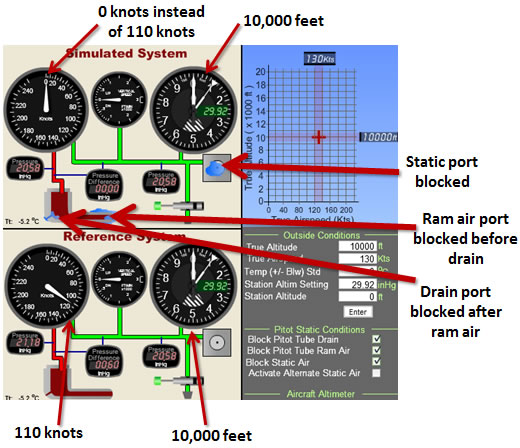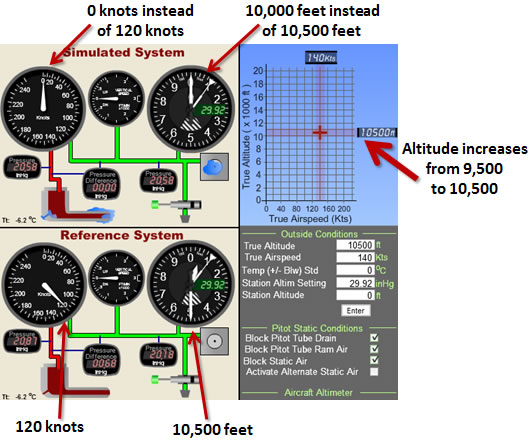|
1c. Static port and Pitot tube drain blocked (regardless of order); but ram air remains unobstructed.
Here the behavior is exactly the same as in the example of scenario 1a. The pilot will not notice any difference between the two scenarios as long as the ram air remains unobstructed. If the ram air then becomes obstructed after the Pitot tube drain, the problem becomes scenario 1d.

Fig 4-15 Static air port and Pitot drain blocked.
The Pitot tube drain is a much smaller orifice in comparison to the ram air port (located at the front of the Pitot tube). Unless the ram air is also blocked there usually will be no significant additional effect other than the effect of the static port being blocked in this example (Fig 4-15).

Fig 4-16 Aircraft climbs 500 feet from the altitude where blockage occurred.
When the aircraft climbs 500 feet (Fig 4-16) from the altitude that blockage of the ram air and static port occurred
the effect is the same as if only the static port had been blocked. Compare figure 4-16 with figure 4-2 from scenario 1a.
1d. Pitot tube drain blocked; ram air blocked after Pitot drain; static port drain blocked (regardless of order).

Fig 4-17 Static port blocked followed by Pitot tube drain, then ram air at 10,000 feet and 130 knots true airspeed.
Whenever all three (static port, ram air and Pitot tube drain) get blocked the airspeed indicator, VSI and altimeter freeze at their current indications. It would be somewhat unlikely that all three would freeze at exactly the same time, however if the aircraft maintains altitude and airspeed the result will be the same even if each opening gets blocked at a different time. This will happen provided the ram air gets blocked after the Pitot tube drain (Fig 4-17). In the case the ram air gets blocked before the drain the indicated airspeed would indicate zero. In all cases, including those where the aircraft has changed altitude and airspeed, at the moment all three openings get blocked the Pitot static instruments will freeze at their current readings regardless of what they are. In figure 4-17 the aircraft is flying at 10,000 knots at a true airspeed of 130 knots when all three (static port, ram air and Pitot tube drain) openings are blocked. The pressure is trapped now inside the Pitot tube chamber (21.18 inHg) and static air line (20.58 inHg). The difference between the two will also remain the same and that is why the airspeed indicator also freezes.

Fig 4-18 Aircraft climbs to 11,500 feet and decreases true airspeed from 130 knots to 60 knots.
Suppose the aircraft now climbs to 11,500 feet and slows down to a true airspeed of 60 knots. Because air is trapped in the system none of the instruments will show any change (Fig 4-18) from the time of the blockages. For comparison, the reference system shows what the correct indications would be if there were no blockages.
1e. Ram air blocked; Pitot tube drain after ram air; static port drain blocked (regardless of order).

Fig 4-19 Static port blocked followed by ram air then Pitot tube drain, at 10,000 feet and 130 knots true airspeed.
In this example (Fig 4-19) an aircraft flying at 10,000 feet with a true airspeed of 130 knots experiences a blockage in the static port. In addition, the ram air opening gets blocked, followed by the Pitot tube drain opening. As in the previous examples, the static port being blocked will cause the altimeter to freeze at its current altitude and the vertical speed indicator (VSI) to remain at zero regardless of any altitude change. Because the ram air opening becomes blocked before the drain opening in this example, the airspeed indicator will drop to zero. This is due to the air being able to equalize in the Pitot tube chamber (20.58 inHg) with the static air (20.58 inHg) outside before the drain opening gets blocked. The air pressure trapped in the static air line is also 20.58 inHg so we have qc = PT - P = 20.58 - 20.58 = 0 inHg which corresponds to a zero indication of airspeed (see chart 2-3).

Fig 4-20 Aircraft descends 500 feet and increases true airspeed by 10 knots.
Any time the three openings (static port, ram air and Pitot tube drain) in the Pitot static system are blocked all the instruments will freeze. An increase in true airspeed and a decrease in altitude have no effect on the airspeed indicator, vertical speed indicator and altimeter (Fig 4-20).

Fig 4-21 Aircraft climbs 1000 feet (500 feet above blockage altitude) and maintains airspeed.
In figure 4-21 the aircraft climbs to 10,500 feet. As expected the change in altitude had no effect since all three openings are blocked.
Possible actions that the pilot can take to clear these blockages include activating the alternate static air port (if available) which should get the vertical speed indicator and altimeter to function with a slight error. If the obstruction of the ram air opening and Pitot tube drain opening are due to ice, the pilot can activate the Pitot tube heat.
|

